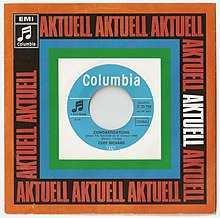Columbia Graphophone Company
The Columbia Graphophone Company was one of the first gramophone -Unternehmen the United Kingdom .
Early history
In 1922, the US company Columbia Phonograph (later: Columbia Records) sold its British subsidiary Columbia Graphophone . In 1925, however, Columbia Graphophone bought its former parent company itself for $ 2.5 million. In 1926 Odeon Records and Parlophone Records were acquired. On April 21, 1931, the Gramophone Company of the gramophone inventor Emil Berliner and the British Columbia Graphophone Company merged and formed a new company - Electric and Musical Industries ( EMI ). However, US competition law forced EMI to sell its American operations. These then ran independently as Columbia Records , but until the 1970s they still had occasional distribution agreements with EMI, so that EMI partly sold Columbia releases in the UK and Europe, while Columbia did the reverse with EMI releases in the USA.
With the founding of EMI in 1931, a bond was formed with the Japanese Nippon Phonograph Company , founded in 1910 , which then took over the name and trademark of the British Columbia Records, but otherwise remained independent. In 1946 it was renamed Nippon Columbia Company Limited and has been operating as Columbia Music Entertainment since 2002 , without any relationship with the US Columbia label, whose products are now sold in Japan under the name Sony Music .
Columbia as an EMI sub-label

EMI continued to operate Columbia as a record label outside of the United States, Canada, and Japan until the early 1970s .
Under EMI, the Columbia releases consisted primarily of licensed releases of recordings from the American Columbia Records. That changed in 1951 when Columbia (US) switched to Philips Records for British distribution . Columbia (EMI) continued to sell sister labels to Columbia (US) (including Okeh and Epic ) until the 1960s . The then parent company of Columbia (US), CBS , then switched the distribution of all their record labels to the newly founded label CBS Records, whereupon Columbia (EMI) had to adapt and promote its own artists. The artists and bands that Columbia (EMI) established itself in the period that followed included Russ Conway , Cliff Richard , The Shadows , Helen Shapiro , Frank Ifield , Rolf Harris , Freddie & the Dreamers , The Dave Clark Five , The Animals , Herman's Hermits , Gerry & the Pacemakers , The Seekers , Pink Floyd and The Yardbirds . Led by the legendary A&R man Norrie Paramor , the label was one of the most successful labels in Great Britain in the early rock era before the so-called “Beat Boom”.
Discontinuation of the label by EMI and transfer of the trademark rights
The EMI decided to reserve the HMV label for their classical repertoire and therefore transferred all of HMV's remaining pop artists to the Columbia sub-label by 1967. This was replaced in 1972 by the newly formed EMI Records label, which was first named after the company name. The remaining rights to the label name Columbia were sold in 1990 to Sony Music , who had taken over CBS Records (inner-American name of Columbia Records) two years earlier and had the naming rights to CBS only until 1991, i.e. the worldwide rights to the name Columbia as a replacement required. The formal transfer of the UK registered Columbia trademarks, including the Magic Note logo, was completed in 1993. Today, however, Sony Music prefers the so-called "Walking Eye" logo for Columbia Records in Great Britain and Europe, which was previously used for the former label CBS.
Columbia outside the UK / Europe
The history of the Columbia record label outside the UK and Europe is detailed in the article on Columbia Records .
Individual evidence
- ↑ Trade mark number UK00000402839 ( English ) Intellectual Property Office. Retrieved February 12, 2019.